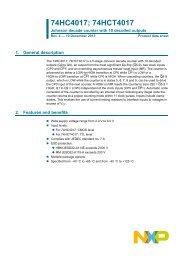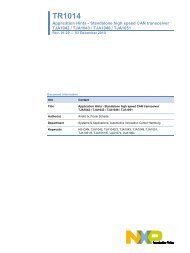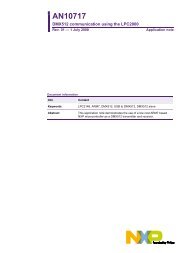AN108711 - NXP Semiconductors
AN108711 - NXP Semiconductors
AN108711 - NXP Semiconductors
You also want an ePaper? Increase the reach of your titles
YUMPU automatically turns print PDFs into web optimized ePapers that Google loves.
Philips <strong>Semiconductors</strong><br />
Application Note<br />
Tips and Tricks for PN51x Integration<br />
number of valid bits. Since the first anti-collision command is two bytes long, the NVB is<br />
set to 20h.<br />
In step 3 the command is assembled (e.g. in the first step: 93h 20h) and then sent via the<br />
RF field.<br />
In step 4 the ISO/IEC 14443-3A - compatible devices will respond with their Manchester<br />
coded UIDs in a bit-synchronous manner. If no collision has been detected, the complete<br />
UID is known by the response of the PICC. Therefore a selection of the PICC can be<br />
performed. This is done in step 9 and step 10. Now the SAK byte (which is sent back<br />
from the PICC after the selection) gives the PCD the information if there is an additional<br />
cascade level. This decision is done in step 11. If there is an additional cascade level,<br />
proceed to step S, otherwise the selection process is finished which is denoted by the<br />
step E.<br />
Collisions in step 5 are recognized by checking the code validity of the Manchester<br />
coding (this is done by hardware). If at least two cards are responding and at least one<br />
bit is different (which is always the case in Mifare, since unique IDs are guaranteed), the<br />
hardware stores the position, determines the valid bits, and sets NVB to this value. The<br />
part of the UID, which has been transmitted<br />
before the collision is the valid section. This<br />
is determined in step 6. The<br />
bit position, where the collision itself has been occurred is<br />
specified by the reader and also taken as a valid bit and set by the reader. The new value<br />
NVB is defined in step 7.<br />
In step 8 the new ANTICOLLISION command is assembled by concatenating the SEL<br />
byte, the new NVB and the known part of the UID including one single bit which is<br />
defined by the PCD. By defining this bit, one of the targets will be excluded.<br />
Now step 3 is performed once again. This cycle is performed until the whole UID for the<br />
current cascade level is complete. In worst case, if a collision takes place at every bit<br />
position, the loop has to be passed 32 times per cascade level (at least 32 cards in the<br />
field).<br />
If the anti-collision process has terminated, the PICC is active and the PCD can<br />
determine<br />
if the PICC is the appropriate one. If not, the PCD can set this PICC into the<br />
HALT mode and redo the anti-collision process with the next PICC.<br />
© Koninklijke Philips Electronics N.V. 2006. All rights reserved.<br />
Application note Rev. 01.10 — 11. May 2006 31 of 37





